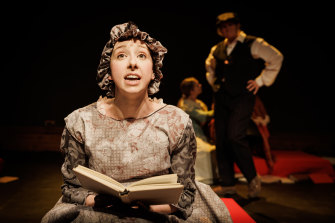THEATRE
Adapted by Christine
Davey from the novel by Charlotte Brontë
By Skin of our Teeth Productions
At La Mama Courthouse until July 17, 2022
Reviewer: Kate Herbert
Stars: **1/2
This review was first published in The Age Arts online on Sunday July 10, then in print on Monday July 11 2022. Click link to read my review of Jane Eyre online at The Age Arts. k
Tess Parker as Jane Eyre at La Mama Courthouse. Credit:Darren Gill
Adapting a novel to stage – even a great, dramatic novel – isn’t a guarantee of great drama.
Difficulties can rear their heads: for example when the script, trying to stay “true” to the text, unimaginatively transposes chunks of the original prose on stage as dialogue and narration. Another danger is trying to cram too many episodes and narrative threads into the play.
Christine Davey’s adaptation of Charlotte Brontë‘s classic novel Jane Eyre for the Skin of our Teeth company sees Jane Eyre (Tess Parker) narrate the 130-minute production, delivering extracts of Brontë’s prose directly to audience, even addressing us as “dear reader”.
Brontë‘s tale begins with Jane’s early childhood as an orphan mistreated by her Aunt Reed who sends rebellious, defiant Jane to grim Lowood School where she eventually teaches. Plain, passionate Jane later becomes governess to Mr. Rochester’s (Glen Barton) ward at Thornfield Hall where she falls in love with gloomy Rochester who keeps a dark secret hidden in the attic.
Narration from a novel doesn’t have to be deadly to a theatrical production: the triumphant recent production of The Picture of Dorian Gray is evidence of that. Two outstanding UK theatrical adaptations of Jane Eyre – by Shared Experience (1999) and National Theatre Live (2020) – included much of Brontë’s text but then took imaginative leaps, translating Jane’s experiences into stark, physicalised, volatile performances that remained true to the spirit of the novel. It is impossible not to compare this version, that includes too much narration and too little action, with these adaptations.
“Show don’t tell” is a simple mantra, but this production does too much telling and not enough showing, although the scenes that convert Brontë’s prose to dialogue instead of narration are more engaging. This unimaginative production, with its multiple entrances and exits, frequent moving of chairs, and long, onstage costume changes, cries out for inspiring physicalisation.
The evocative cello and dulcimer (Barton and Simon Carroll) could be used more frequently to underscore dialogue, intensify atmosphere and punctuate scenes, while the snatches of songs could benefit from harmonies or accompaniment.
Parker commits to her role as Jane, delivering tracts of narrative with clarity and earnestness. Gracie Rogers is credible as warm Miss Temple, spirited Adele and wild-eyed Bertha. Other performances are characterised by awkward physicality, forced vocal quality, shouting instead of commitment, imprecise English accents, and disconnection of dialogue from emotion.
Although their first meeting has potential, there is no simmering desire or palpable connection between Jane and Rochester; even their reunion after Rochester’s dreadful injuries in the fire, lacks the poignancy of the literary version of the scene.
This production fiercely underlines Jane’s quest for independence but fails to tap the passion that is the essence of Jane Eyre – the woman and the story. Ultimately, it does not illuminate the text, penetrate characters, transform the stage with theatrical technique or transport its audience to another place or time.
Reviewed by Kate Herbert

No comments:
Post a Comment